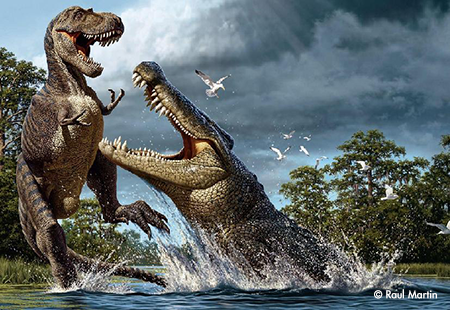
Opening July 12, “Dinosaurs – The Lost World” is a stunning new, original exhibit developed by Cranbrook Institute of Science in collaboration with John and Jack Hankla, who have assembled one of the world’s most significant private fossil collections, The Hankla Collection.
The exhibit features more than 50 species of non-avian dinosaurs and contemporary marine reptiles, pterosaurs and birds (avian dinosaurs) from 20 Cretaceous rock formations in North America and Eurasia – many are newly described species never displayed in Michigan.
In addition, there are more than 60 complete skeletal mounts of research quality casts and several real skeletons, five types of fossil eggs, skin impressions, plants and invertebrates displayed in three galleries covering over 6,000 square feet; A 36′ long molded track way with the foot prints of four dinosaurs and traces of other contemporary animals, the only cast of its kind from the end of the dinosaur era in North America; and a 4′ by 8′ slab of sandstone loaded with real fossil bones preserved in coastal lagoon storm deposits, including numerous Edmontosaurus and T. rex bones and teeth.
For children, there will be a special area with excavation activities and a focus on how paleontologists and geologists, plan, search for, collect and artistically restore the form of dinosaurs and other extinct organisms.
Other features include special Dino Prep Lab days when visitors can help prepare real dinosaur fossils still in rock and field jackets from the Late Cretaceous Lance Formation collected from the Hankla Ranch in Wyoming; and special lectures by local and visiting paleontologists and geologists.
There will also be gallery guides for visitors and special teacher guides available on-line, outlining key educational benchmarks for various grade levels, with QR codes and links to on-line data and images.
The primary focus of the exhibition is on the incredible diversity of dinosaurs, pterosaurs and marine reptiles of western North America during the Late Cretaceous Period. These animals lived in a super warm, lushly vegetated western Lost World landmass called Laramidia, which was isolated for 20 million years by a seaway extending through the center of North America, from the Gulf of Mexico to the Arctic Ocean. Dinosaur faunas range from the north slope of Alaska to Mexico.
The main gallery is anchored by new specimens from the strata of southern Utah recently reviewed in the March 2012 issue of Scientific American; including the newly described tyrannosaur Teratophoneus and the bizarre new ceratopsian Kosmoceratops bearing 15 horns on its head, along with the contemporary monstrous 30′ crocodile Deinosuchus. Especially awe-inspiring is the newly discovered largest known specimen of the giant 22′ long, armored tank-like ankylosaur Peloroplites.
Highlights of the Wyoming component from the Hankla ranch include: an adult hadrosaur, Edmontosaurus paired with a complete mounted skeleton of a juvenile; an awesome Struthiomimus nicknamed claws; the large marsupial Didelphadon, and a composite specimen representing the controversial predator Nanotyrannus.
The marine fauna of the seaway is anchored by a 33′ foot long skeleton of a newly described species of the ferocious mosasaur Prognathodon accompanied by Archelon the world’s largest turtle, and the diving bird Hesperornis. Four species of pterosaurs patrol the skies including Pteranodon longiceps with a 24′ wingspan!
A special feature of Dinosaurs – The Lost World is a fascinating comparison between the Late Cretaceous dinosaurs of western North America with time equivalent dinosaur communities from Central Asia, highlighted by complete skeletal mounts of the terrifying Mongolian tyrannosaurs Tarbosaurus and Alioramus along with a pack of marauding velociraptors, and groups of fleeing conchoraprors, protoceratopsians, and psitaccosaurs.
In addition to the awe-inspiring newly discovered specimens and related activities, Dinosaurs – The Lost World is one of the most up to date exhibits featuring the current state of knowledge of this remarkable period in Earth history – with something for everyone.
Cranbrook Institute of Science is located at 39221 Woodward Avenue in Bloomfield Hills. Hours, through Sept. 1 are Monday-Thursday: 10 a.m.-5 p.m.; Friday/Saturday: 10 a.m.- 10 p.m.; and Sunday: Noon-4 p.m.
Call (248) 645-3200 for more information.